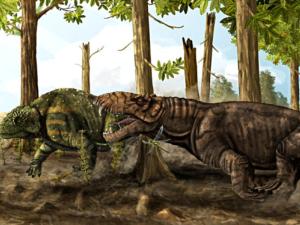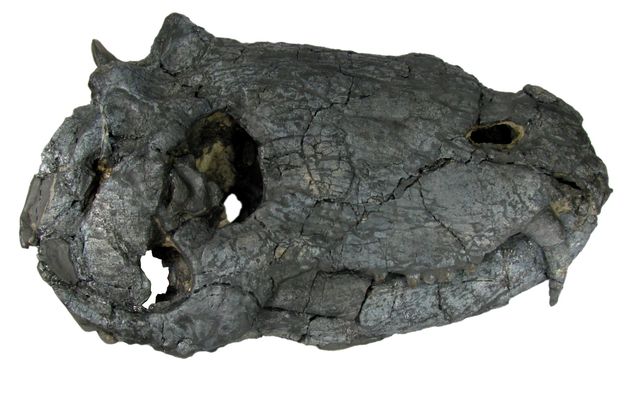Ancient Permian Predator from Brazil Described in New Scientific Paper
Fierce Brazilian Predator that Roamed Long Before the Dinosaurs
Long before the dinosaurs evolved, terrestrial habitats were dominated by different kinds of reptiles, some of which were fearsome hunters, larger than most of the land carnivores found today. A team of South American scientists have published a paper on one such formidable creature – an animal with huge canine teeth like a modern day tiger, but weighing twice as much as the biggest “big cats” around.
Ancient Permian Predator
Named Pampaphoneus biccai this new genus of ancient reptile is believed to be the earliest, large predator discovered to date in South America. The name means “Bicca’s Pampas Killer”, honouring the land owner (José Bicca), as the fossils were found on his farm. Described as a Dinocephalian therapsid, a group of Late Permian to Triassic reptile-like synapsids that include the ancestors of mammals, this animal was probably the top predator in the region in the Late Permian.
Pampaphoneus biccai – Vicious Permian Predator
Picture credit: Voltaire Neto/Wits
Known from just a single skull, the fossils were first unearthed back in 2008, but the scientific paper which has been published in the scientific journal Proceedings of the National Academy of Sciences, was delayed as it took many hundreds of hours to carefully piece the skull together from the many fragments that had been found at the fossil site.
Pampaphoneus biccai
The discovery will help scientists to understand how this type of therapsid reptile diversified towards the end of the Permian period – Guadalupian/Lopingian epochs (265-260 million years ago), as they gradually replaced the pelycosaurs (animals such as the sail-backed reptile Dimetrodon), as the dominant large vertebrates on land.
To discover exposed sediments on the extensive grasslands of Brazil, the scientists employed images from Google Earth to assist them in their search. Satellite images helped the team identify potential fossil sites which were not covered by vegetation, thus permitting the rock layers to be explored more easily. This is not the first time that satellite technology has been employed to search for fossils in this way, many dinosaur fossils have been found using this technique.
With much of the Earth’s surface comprehensively mapped, scientists are able to pin point with great accuracy potential fossil yielding dig sites. In the past, such locations were often discovered by painstakingly walking over an area or relying on reports of unusual finds from locals.
The restored skull measures over 35 centimetres in length. It indicates that with its over-sized canines and other saw-like teeth this predator had a powerful bite.
Using more complete fossil specimens found in the Karoo Basin region of South Africa, the Brazilian palaeontologists have been able to build up a picture of what this four-footed predator looked like. They estimate that it would have been over 3 metres in length, weighing in excess of 300 kilograms. This makes it larger and heavier than the largest species of “big cat” predator found today. Consider the prospect of a Komodo Dragon with the power and strength of a Siberian Tiger, and you are beginning to get an impression of what “Pampas Killer” would have been like.
The Restored Skull of Pampaphoneus biccai
Picture credit: Dr Juan Cisneros
The Brazilian scientists worked with other palaeontologists and experts from Turkey and South Africa as they studied the skull bones and began to piece them together. South Africa, the region known as the Karoo Basin, is a particularly rich source of Late Permian reptile fossils. During the Late Permian, most of the land masses were squeezed together to form a single super-sized continent known as Pangea.
The southernmost portion of Pangea consisted of South America, Africa, India, Antarctica and Australia. Studies of fossil plants found in these regions indicate that Pampaphoneus biccai lived in a relatively cool, forested climate. This suggests that during the Late Permian, Brazil was actually much closer to the South Pole than it is today.
For models and replicas of prehistoric creatures from the Permian: CollectA Prehistoric Life (Deluxe Models).
Scientists hope to use the fossil evidence from South America to help build up a picture of therapsid diversification and migration during the Late Permian. P. biccai may have been a very formidable predator, but this type of reptile was doomed to extinction just a few million years later. Changing sea levels, an asteroid/comet impact and extensive flood basalt eruptions in what was to become Siberia led to perhaps the most devastating mass extinction event identified to date in the fossil record.
Ninety-five percent of all types of life on Earth became extinct at the end of the Permian. The therapsid group of reptiles were severely affected. Some twenty-one families of therapsids (63 percent) died out.



